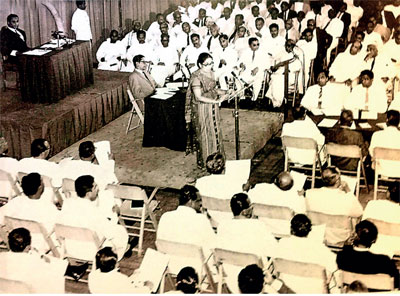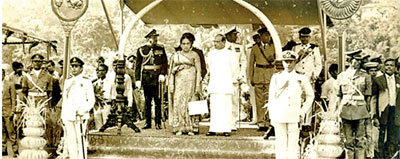Sri Lanka becomes a Republic
Ceylon – as Sri Lanka was then known – gained Independence on February 4, 1948. Till then we were a Crown Colony in the British Empire for a little over 150 years after the British took over administering the country from the Dutch in 1796.
A Parliamentary system of government based on the British system – generally known as the Westminster model – was introduced just before Independence.

Prime Minister, Mrs. Sirimavo Bandaranaike addresses the Constituent Assembly.
It comprised the House of Representatives (Lower House) with 95 members (known as Members of Parliament) and six appointed by the Governor representing the British monarch, and the Senate (Upper House) with 30-members, 15 of whom were elected by the House of Representatives and the other 15 appointed by the Governor on the advice of the governing party.
Twenty four years after Independence the country changed its Constitution and became a Republic on May 22, 1972. It marked the birth of the Socialist Republic of Sri Lanka. That was the day when the official name of the country was changed from ‘Ceylon’ to
‘Sri Lanka’. It should be noted that although the country until then was known as ‘Ceylon’ in English, from ancient times ‘Sri Lankava’ or ‘Lankava’ was the name of the country in Sinhala. Often the term ‘Sri Lankadvipaya’ was used, meaning the ‘Island of Sri Lanka’.
With the formation of the Republic, a President took the place of the Governor-General, ceremonial Head of State who was appointed by the British monarch (Queen Elizabeth II) on the recommendation of the Government of Ceylon. The incumbent Governor-General William Gopallawa continued to be the Head of State as the first Non-Executive President under the new constitution. He was a nominee of the Prime Minister and not an elected President.
Let us now see how the new Republican constitution was adopted.
The signs of a new constitution started in June 1968 when the main Opposition parties in Parliament –
the Sri Lanka Freedom Party (SLFP), the Lanka Sama Samaja Party (LSSP) and the Communist Party (CP) – formed a ‘United Front’ and agreed to establish “a socialist democracy”. The United Front won the general election held on May 27, 1970 and a government was formed with Mrs. Sirimavo Bandaranaike as Prime Minister.
The government decided to draft a new constitution and on a resolution by the Prime Minister, the members of the House of Representatives formed themselves into a Constituent Assembly at a meeting held at the Navarangahala in Colombo on July 19, 1970. The Speaker, Stanley Tillekeratne was elected as Chairman. Minister of Plantation Industry, Dr. Colvin R. de Silva was given the additional portfolio of Constitutional Affairs.
On a decision made by the Government, the Senate was abolished in October 1971. The bicameral legislature (two law-making institutions) became a unicameral (single law-making body) thereafter. On May 22, 1972, after prolonged discussions, a new Republican Constitution – the Socialist Republic of Sri Lanka – was adopted.

The first President of the Republic of Sri Lanka, William Gopallawa and the first Prime Minister, Mrs. Sirimavo Bandaranaike.
A ‘National State Assembly’ (NSA) was created in place of the House
of Representatives. The same elected members at the 1970 general election continued as members of the NSA.
Executive President
When the United National Party (UNP) won the general election in May 1977 under the leadership of J. R. Jayewardene the government took steps to amend the 1972 Constitution and establish the post of Executive President.
The new constitution drawn up by a Select Committee of the National State Assembly was adopted and the
‘Sri Lanka Democratic Socialist Republic’ was promulgated on September 7, 1978,
repealing and replacing the 1972 Constitution. The Executive President wielded wide powers.
The Executive President was to be elected by the people once every six years and he/she could call for a mandate from the people any time after four years in office.
Prime Minister J. R. Jayewardene was installed as the first elected President on February 4, 1978 at a ceremony at Galle Face when he was sworn in before the Chief Justice, Neville Samarakoon.
R. (Ranasinghe) Premadasa, Minister and Colombo Central MP was appointed Prime Minister.
The National State Assembly was replaced by the ‘Parliament’. There were 168 elected Members of Parliament following the increase in the number of electorates.


